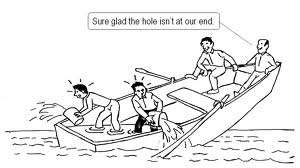 A resource development colleague called me a few weeks ago. They were upset and pissed off after a recent board meeting, and they just wanted to vent their anger. As a good friend who was just asked to lend a shoulder to cry upon, I shut-up and listened. I didn’t offer any advice because it wasn’t asked for; however, the situation that was shared with me has been burning on my mind for weeks. It is such a serious issue that I thought I’d share it here and open it up for discussion.
A resource development colleague called me a few weeks ago. They were upset and pissed off after a recent board meeting, and they just wanted to vent their anger. As a good friend who was just asked to lend a shoulder to cry upon, I shut-up and listened. I didn’t offer any advice because it wasn’t asked for; however, the situation that was shared with me has been burning on my mind for weeks. It is such a serious issue that I thought I’d share it here and open it up for discussion.
In a nutshell, here are the facts that color this story:
- The development director is a fixture in the boardroom and gives a “development report” at every meeting.
- After delivering their report, a board member asked a question about what the development department might look like in the future.
- While the development director had talked with the executive director about this issue in passing on a few occasions, neither of them had formally engaged on this subject in a meaningful way.
- The answer caught the executive director off guard a little bit, and they jumped into the conversation with a “sharp tongue”. This response felt demeaning to the development director, and they felt “put in their place” in front of the board of directors.
- In the days following the board meeting, the development director was verbally reprimanded and given what HR people would describe as a “verbal warning”.
 I am very sympathetic to my resource development friend. It feels like the response was harsh; however, as a former executive director, I hated surprises in the boardroom, and I was a bit sensitive to how my employees interacted and engaged with board members.
I am very sympathetic to my resource development friend. It feels like the response was harsh; however, as a former executive director, I hated surprises in the boardroom, and I was a bit sensitive to how my employees interacted and engaged with board members.
All of this aside, I wonder what is the appropriate role for resource development professionals inside the boardroom. Is there one? Should the boardroom just be a place for an agency’s chief executive officer and the board of directors?
I am sure there are a number of you ready to share your thoughts about how important it is for fundraising professionals to have access to board volunteers and how strong relationships with volunteers are the key to a strong resource development program.
While I will be the first to agree with you, I keep wondering why does that need to occur in the boardroom?
Don’t resource development directors “have access” at resource development committee meetings? Special event planning meetings? Over a cup of coffee or lunch?
Isn’t the boardroom a sacred place where board members and their sole employee — the executive director — get to have frank conversations about the agency and its strategic direction?
 There are so many other tangent conversations I could bring into this blog post such as:
There are so many other tangent conversations I could bring into this blog post such as:
- What role should an executive director play in the agency’s resource development program when there are fundraising professionals on the payroll?
- What should the communication protocol be for agency employees who report to the executive director and need access to board members?
- Should development professionals guard against sharing their opinions with board members when the executive director hasn’t been fully brought into the conversation? If so, how? If not, why not?
However, I want to stop the conversation just short of those topics and just focus on the boardroom question. What staff are allowed in your agency’s boardroom? What function do they serve? What protocols are in place to ensure situations like the one I just shared with you don’t happen?
Here’s to your health!
Erik Anderson
Founder & President, The Healthy Non-Profit LLC
www.thehealthynonprofit.com
erik@thehealthynonprofit.com
http://twitter.com/#!/eanderson847
http://www.facebook.com/eanderson847
http://www.linkedin.com/in/erikanderson847

My initial reaction to the post was to wonder why the Director of Development is giving the report to the Board. I would argue, and often have, that it should be the Chair of the Development Committee giving the report. If it had been, in this case, the Chair would have been the one fielding the question and the issue that followed would have been avoided. Additionally, the Chair would be viewed as the correct person to ask this question instead of the staff who is not tasked with setting strategic direction, merely implementing their part of the strategic direction that Board has set. The Executive Director, who is tasked with stewarding the strategic plan, would be the person most able to speak to what any and all departments might look like in the future, through the lens of the plan the Board has set. All of this leads me to questions:
1. Is everyone in this organization clear about their role and the boundaries of those roles?
2. Is there a strategic plan?
When I am in the Executive Director seat, I try to set things up as follows:
Initial orientation and annual trainings for Board members that include some version of roles and responsibilities.
I (try very hard to ) let the Board do the work of the Board and I do the work of the Exec, while training my staff to their roles and the boundaries of those roles.
I ask my staff to cc me on communications to individual Board members and also talk to staff (and occasionally to the board) about Board process and the staff’s role at Board meetings, which is generally to answers questions and to make occasional presentations, by request.
I have traditionally invited my senior staff to come to board meetings; it is a good learning experience and good exposure for them, especially if they aspire to one day be an Exec. It does occasionally makes things awkward which is why setting up boundaries in advance are so important.
Good post and good questions. I look forward to learning from the experiences and comments of others!
Thanks for weighing in, Dani! You provide some great suggestions, and I like your approach to setting boundaries. When I was an exec, I got to the point where I only invited staff into the boardroom for specific portions of the agenda that might require their participation. I didn’t start off that way, but I made this adjustment after one of my development directors thought they should be the executive director and started stirring that pot with individual board members. I don’t think there is a right or wrong way to address this issue just as long as the boundaries you talk about are established.
As for this specific agency, they are lacking much of the organizational development structure you allude to. There is confusion among board volunteers about roles & responsibilities. I don’t think there is a strategic plan. Unfortunately, this is very common for many NFPs and it always bites people in the rear-end.
I am hesitant about sharing too many specifics out of respect for that organization. The development director is also a blog subscriber.
I, too, hope others decided to share their thoughts because I agree with you about wanting to hear how others are dealing with such an interesting question.
I hope all is well!
~Erik
I agree with Dani that the development committee chairperson should be the one making the reports. That’s a peer-to-peer interaction that is vital to the structure and strength of the board. Boundaries and a clear understanding of each person’s role is crucial, too.
For a “brief” answer, the DoD should have looked to the ED for an answer. Even a polite: “While the ED and I have had conversations about this particular topic, we have not formally created/developed a plan, yet. You could say we are in the process. Would you like to add anything else, [insert ED’s name]?” Maybe even ask said board member if they are interested in helping since they asked. It’s not easy to handle a surprise question, but I think lesson learned here, too, is to anticipate questions like this especially at a board meeting and depending on what you may be talking about. There’s more than just being prepared for what you want to present.
Also, from the scenario described, the ED should not have put the DoD in his/her place in front of the board. That was unnecessary and the ED could have strategically smoothed things over without making the DoD feel inferior to the most important leadership group within the organization. In turn, I don’t believe the DoD should have received a “warning” – if the DoD was winging the question….how can anyone fault him/her for the answer unless he/she crossed an inappropriate line? A warning seems to be a bit of overkill. Why not be proactive instead and address the answer to the board member’s question so that neither ED nor DoD will be caught off guard again?
Thanks for your two cents. Of course, I agree wholeheartedly!
I also think that if a non-profit CEO allows staff into the boardroom, then they need to be prepared for the occassional surprise. Verbal warning? Dressing down and putting people in their place? My first thought was “REALLY?” I’m not sure how long I can work there if I was the development director.